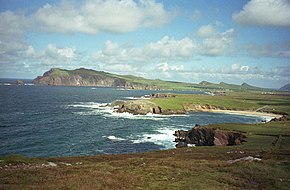Dingle Peninsula
| Dingle Peninsula | ||
 Location of the Dingle Peninsula |
||
| Geographical location | ||
|
|
||
| Coordinates | 52 ° 12 ′ N , 10 ° 5 ′ W | |
| Waters 1 | Atlantic Ocean | |
| length | 50 km | |
| width | 9 km | |
 West coast of the Dingle Peninsula |
||
The Dingle Peninsula ( english Dingle Peninsula , Irish : Corca Dhuibhne / ˌkɔrkə ɣ ɰ iːnʲɪ / , according to an ancient tribal group) is in County Kerry , in the province of Munster in Ireland . It got its Anglicised name from the place Dingle ( An Daingean ), which lies in the west of the 50 km long and an average of nine km wide peninsula .
Geology and history
The mountainous peninsula is littered with prehistoric and early historical monuments, especially in its western part. Stands out among the attractions the Gallarus Oratory , a rustic Kraggewölbebau from early Christian time, as the Beehive huts of Fahan and Killelton Oratory in drywall technology was built. But also wedge tombs ( The Giants Table , Maumnahaltora and Púicín an Chairn ), stone boxes ( Knockane ), cup-and-ring markings , menhirs (Cloonsharragh and Ballineetig ), ring forts , rows of stones (Ardamore) and Promontory forts ( Caherconree , Dunbeg Fort , Dunmore) as well as Cross Slabs (Knockane), Ogam ( Ballintaggart , Coumeenoole North ) and Bullaun stones can be found here. Another group are early Christian church ruins ( Kilmalkedar and on one of the Magharee Islands ). Relics such as the Cloghane church , the Garfinny Bridge and the Pillar Stones of Kilfountan and Reask , as well as the ruins of churches ( Kilvicadownig ) and monasteries ( Raingiléis ), old castles (Minard) are part of the landscape of the peninsula. The port of Smerwick (north. Butterhafen) got its name from the Vikings , who presumably maintained a base here.
Involvement in Gaelic mythology
According to Lebor Gabála Érenn ("The Book of the Capture of Ireland"), 2242 years after the creation of the world, Cessair , a granddaughter of Noah, landed on the Dingle Peninsula .
Ith later arrives here from Breganza in Spain and is killed. The Tuatha dé Danaan , the mythical fairy people of the Irish legend, lose the battle on the Slieve Mish (the Phantom Mountains) against the Milesians or the Gael who want to avenge the death of Ith. Two queens of the comers Scota and Fais (Fai or Fas) fall. Fai's grave (a hill on which the ruins of a tiny church stand) is located in Glenfash near Camp , while Scota is mythically buried in Glenscoheen ( Scota's Glen ).
The east, where the 600 m high Fort Caherconree is located, is associated with Cú Rois and Cú Chulainn .
The southwest is connected with the Battle of Ventry , which the Fianna fight with Donn , the "King of the World".
The north coast is the area of St. Brandon (Brandon the Navigator). Processions still take place here to the 952 m high third highest mountain in Ireland, Mount Brandon , which can be seen from Connor Pass like a row of ants in the distance. Mt. Brandon was previously a sanctuary of the god Lugh (corresponding to the pan-Celtic Lugus ), and this is where Lughnasadh (the beginning of autumn and the harvest festival) was once celebrated.
tourism
The Dingle Peninsula is next to the Ring of Kerry , which is located on the Iveragh Peninsula to the south , the main tourist attraction in south-western Ireland. Tourism is promoted by boat trips to the Blasket Islands , fishing and bike tours, golf courses, horse riding and covered wagon holidays, and hiking routes. A very flat sandy beach on the Inch Spit and the Slea Head Drive, the western coastal road , are of great tourist interest . There are some lovely day hikes on Dingle, e.g. B. on the Sliabh Mis or Mount Brandon and as a long-distance hike the Dingle Way ; from Tralee via Camp, Annascaul , Dingle , Dunquin , Ballydavid, Cloghane and Castlegregory to Tralee.
See also
literature
- Sylvia Botheroyd : Ireland - Mythology in the landscape: a travel and reading book . Häusser-Verlag, Darmstadt 1997, ISBN 3-89552-034-9 .
- Steve MacDonogh: The Dingle Peninsula: History, Folklore and Archeology . Brandon, 1993 ISBN 0-86322-159-9
- M. Sheehy: The Dingle Peninsula . Travel Guide, 1991


